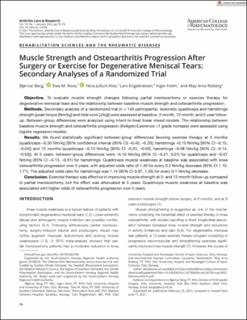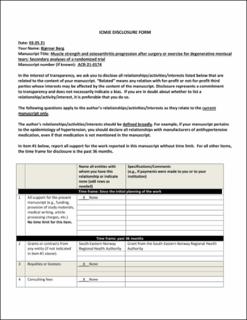| dc.contributor.author | Berg, Bjørnar | |
| dc.contributor.author | Roos, Ewa M. | |
| dc.contributor.author | Kise, Nina Jullum | |
| dc.contributor.author | Engebretsen, Lars | |
| dc.contributor.author | Holm, Inger | |
| dc.contributor.author | Risberg, May Arna | |
| dc.date.accessioned | 2022-03-21T22:45:29Z | |
| dc.date.available | 2022-03-21T22:45:29Z | |
| dc.date.created | 2021-12-10T11:59:31Z | |
| dc.date.issued | 2022 | |
| dc.identifier.citation | Arthritis Care & Research. 2022, 74(1), Side 70-78. | en_US |
| dc.identifier.issn | 2151-464X | |
| dc.identifier.uri | https://hdl.handle.net/11250/2986647 | |
| dc.description | This is an open access article under the terms of the Creative Commons Attribution-NonCommercial License, which permits use, distribution and reproduction in any medium, provided the original work is properly cited and is not used for commercial purposes. | en_US |
| dc.description.abstract | Objective: To evaluate muscle strength changes following partial meniscectomy or exercise therapy for degenerative meniscal tears and the relationship between baseline muscle strength and osteoarthritis progression.
Methods: Secondary analysis of a randomized trial (n = 140 participants). Isokinetic quadriceps and hamstrings strength (peak torque [Nm/kg] and total work [J/kg]) were assessed at baseline, 3-month, 12-month, and 5-year follow-up. Between-group differences were analyzed using intent-to-treat linear mixed models. The relationship between baseline muscle strength and osteoarthritis progression (Kellgren/Lawrence ≥1 grade increase) were assessed using logistic regression models.
Results: We found statistically significant between-group differences favoring exercise therapy at 3 months (quadriceps –0.30 Nm/kg [95% confidence interval (95% CI) –0.40, –0.20]; hamstrings –0.10 Nm/kg [95% CI –0.15, –0.04]) and 12 months (quadriceps –0.13 Nm/kg [95% CI –0.23, –0.03]; hamstrings –0.08 Nm/kg [95% CI –0.14, –0.03]). At 5 years, between-group differences were –0.10 Nm/kg (95% CI –0.21, 0.01) for quadriceps and –0.07 Nm/kg (95% CI –0.13, –0.01) for hamstrings. Quadriceps muscle weakness at baseline was associated with knee osteoarthritis progression over 5 years, with adjusted odds ratio of 1.40 for every 0.2 Nm/kg decrease (95% CI 1.15, 1.71). The adjusted odds ratio for hamstrings was 1.14 (95% CI 0.97, 1.35) for every 0.1 Nm/kg decrease.
Conclusion: Exercise therapy was effective in improving muscle strength at 3- and 12-month follow-up compared to partial meniscectomy, but the effect was attenuated at 5 years. Quadriceps muscle weakness at baseline was associated with higher odds of osteoarthritis progression over 5 years. | en_US |
| dc.language.iso | eng | en_US |
| dc.subject | exercise therapy | en_US |
| dc.subject | meniscal tears | en_US |
| dc.subject | muscle strength | en_US |
| dc.subject | osteoarthritis | en_US |
| dc.subject | partial meniscectomy | en_US |
| dc.title | Muscle strength and osteoarthritis progression after surgery or exercise for degenerative meniscal tears: Secondary analyses of a randomized trial | en_US |
| dc.type | Peer reviewed | en_US |
| dc.type | Journal article | en_US |
| dc.description.version | publishedVersion | en_US |
| dc.rights.holder | © 2021 The Authors | en_US |
| dc.source.pagenumber | 70-78 | en_US |
| dc.source.volume | 74 | en_US |
| dc.source.journal | Arthritis Care & Research | en_US |
| dc.source.issue | 1 | en_US |
| dc.identifier.doi | 10.1002/acr.24736 | |
| dc.identifier.cristin | 1967036 | |
| dc.description.localcode | Institutt for idrettsmedisinske fag / Department of Sports Medicine | en_US |
| cristin.ispublished | true | |
| cristin.fulltext | original | |
| cristin.qualitycode | 2 | |

